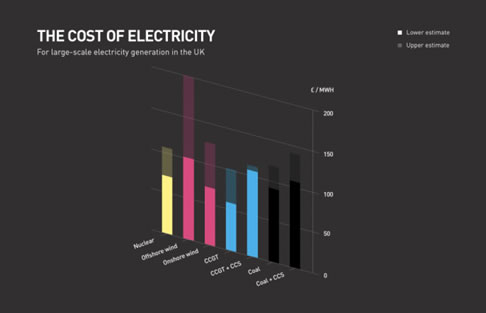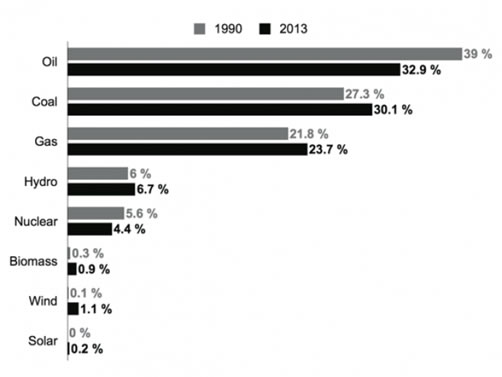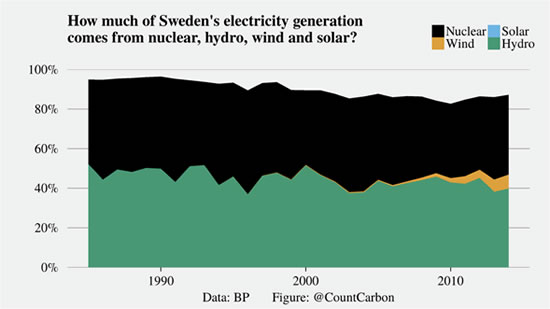

Energy for Humanity: a new voice for the environmental movement
Kirsty Gogan, Director & co-founder of Energy for Humanity
In 2013, the documentary film Pandora’s Promise shattered the long-standing taboo against discussing nuclear energy as an environmental positive. The film created a safe space for nuclear supporters to speak out, and shifted the discourse on nuclear energy. The success of Pandora’s Promise illustrates a tremendous gap in the nuclear education & advocacy space – the need for a strong, independent voice articulating the need for nuclear.
With enthusiasm from Pandora’s Promise still high, but the film’s campaign coming to a close, Film Director Robert Stone, Daniel Aegerter and I co-founded Energy for Humanity (launched in October 2014), to fill that gap.
Our values are that we are global in scope, optimistic, independent and profoundly committed to improving quality of life for all people.
Our main goal should be to replace coal
A key target on our path to limit the world’s temperature increase below 2°C in 2050 is that at least 80% of the world’s electricity must be low-carbon by 2050.
Our main goal in the 21st century should be to replace coal. And yet, here we are: 25 years after the world was first alerted to the need to dramatically reduce carbon emissions or irreversibly alter the Earth’s climate system, and coal remains not only the world’s no.1 source of electrical energy but the fastest growing.
Why is this? The problem is that compared to nuclear plants, which are capital intensive and politically extremely complicated, coal is abundant, quick and easy to build, with little risk for the developer or operator.

Nuclear is the most cost-effective way to cut carbon from large scale electricity generation
Nevertheless, while it’s very difficult to make future cost estimates, many studies show nuclear is the most cost-effective way to cut carbon from large scale electricity generation, as you can see from the graphic above using data from a UK Energy Research Council report. This is also consistent with the recent IEA/OECD NEA report on electricity costs. And this does not include system costs, which means the costs associated with additional grid connection for low-density renewables, or back up capacity for variable renewables. There is considerable research now showing that these system costs become very significant above 30% penetration.
You can see nuclear is the yellow bar on the left, even comparing with coal, nuclear proves to be extremely good value. The difference is the very high up front capital costs, as well as other political risks, whether regulatory, or in terms of public perception, that make financing nuclear plants very challenging.

Sources of world’s energy in 1990 and 2013 - Source BP World Energy Outlook
The result is that, as this graph by Climate Gamble shows, while oil use has (relatively speaking) fallen somewhat, coal use has increased compared to 1990. This despite all the promises and negotiations that have aimed at reducing CO2 emissions, of which coal burning is the largest single culprit. We can also see that while renewables have shown commendable progress, their shares are still very small of the total.
It’s tempting to think that we could reduce our carbon emissions simply by saving energy. But it would be a mistake to over-estimate the role that energy efficiency can play in meeting our carbon reduction targets. Electricity consumption is forecast to grow, and we hope that it will.
We can’t ignore nuclear energy
At present, the majority of environmentalists insist that decarbonisation can be achieved entirely by accelerating the deployment of renewable energy (particularly wind and solar) coupled with dramatic improvements in energy efficiency. Nuclear energy, they say, is simply not necessary to effectively tackle climate change. But just consider the mountain we have to climb when right now wind power provides just 2 per cent of global electricity, and solar just half a per cent! Solar may be the fastest growing source of renewable energy, but coal is the fastest growing source overall, full stop.
If we are serious about tackling climate change, no climate-neutral source should be ignored. That means all the tools in the box: renewables, including hydro and variable sources of power like wind and solar, as well as nuclear and carbon capture and storage. We are especially interested in nuclear since it’s one of the few options available at scale to reduce CO2 whilst providing “baseload” power. “Baseload” means always on, around the clock, whatever the weather.
The Economist newspaper recently asked the question: Which policy actions so far have made a quantifiable difference to cutting carbon emissions? The answer is surprising: Montreal protocol is number one, cutting equivalent emissions by more than 5 billion tons. Hydro power and nuclear energy are numbers two and three. Head and shoulders above anything else. Interestingly, the Chinese one child policy is number 4 on the list, cutting emissions by more than a billion tons.
So nuclear is already making a huge contribution. Nuclear is already a significant source of low carbon power – avoiding the release of 56Gt of CO2 equal to almost two years of total global emissions since 1971.
So while we may think it’s stating the obvious to say that nuclear power is extremely low carbon, with no emissions in operation. Many members of the public do not know that nuclear energy is similar in its emissions to wind and solar.
Nuclear is also an extremely dense source of power, which means a tiny footprint of land for an extremely large output: comparing the land take required to deliver 26TWh per year from nuclear, wind farms or solar farms would amount to 10’s of thousands of acres.
Because the UK has legally binding climate change targets to reduce overall emissions by 80% by 2050, cross party consensus has been achieved that all available technologies should be included. Nuclear is a key plank in the UK low carbon energy strategy, with a 16GW programme of new build planned. Nuclear is seen as not only low carbon, but also reliable and cost effective.
The electricity market has been reformed to create incentives for capital intensive low carbon infrastructure. Today our Chancellor is in Beijing announcing new collaborations between the UK and China to expand clean nuclear energy production.
However, the mantra 'nuclear can't be done quickly enough to tackle climate change' is one of the most pervasive in the debate today and mostly just taken as true, while the data prove the exact opposite.
Only 6 countries meet or exceed the recommendations of the IPCC electricity mix
Just 6 countries in the world have achieved the goal of taking carbon out of their electricity generation. Iceland has geothermal, Norway has hydro, and four countries have achieved the target through a combination of renewables and nuclear: France, Brazil, Switzerland and Sweden.
Let’s look at Sweden. In just two decades Sweden went from burning oil for generating electricity to fissioning uranium.

Research by Dr Barry Brook and Dr Staffan Qvist, published in May this year and based on World Bank data, shows that this appears to be the most rapid installation of low-CO2 electricity capacity on a per capita basis of any nation in history (France and the U.S. installed more total nuclear capacity in the 1960 to 1980s, but less than Sweden on a per capita basis).
“No other carbon-neutral electricity source has been expanded anywhere near as fast as nuclear.” Barry Brook and Staffan Qvist

So these researchers argue that Sweden provides a historical benchmark ‘best-case scenario’ on which to judge the potential for future nuclear expansion.
If the world as a whole were to follow that example, all fossil fuel–fired power plants could be replaced with nuclear facilities in a little over 30 years.
And in terms of costs: Nuclear electricity costs in Sweden have always included a surcharge corresponding to the full estimated costs of researching, building and operating a final repository for all nuclear waste. At the end of the nuclear expansion period, Swedish electricity prices (including taxes and surcharges) were among the lowest in the world, and the running cost of the nuclear plants (per kilowatt hour [kWh] produced) were lower than all other sources except for existing hydropower installations.
Conclusion
No renewable energy technology or energy efficiency approach has ever been implemented on a scale or pace which has resulted in the magnitude of reductions in CO2 emissions that is needed to avert catastrophic climate change.
Real world data shows that a replacement of current fossil fuel electricity by nuclear at a pace which might limit the more severe effects of climate change is technologically and industrially possible.
The projection that fossil fuel electricity generation could be replaced by nuclear globally within 30 years is grounded in reality, being based on actual historical experience rather than speculation on future technological and cost developments.
Whether this will happen depends primarily on political will, strategic economic planning and public acceptance.
It is for these reasons that nuclear must be acknowledged as a proven, scalable strategy for carbon reduction, and included in the climate negotiations at COP21 in Paris this year.
|

